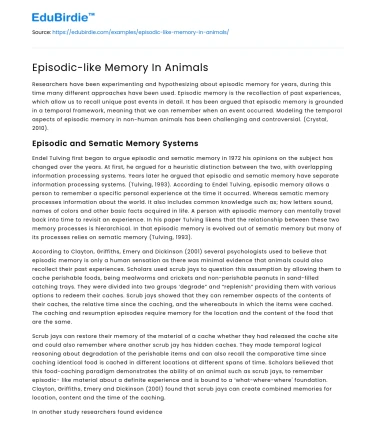Researchers have been experimenting and hypothesizing about episodic memory for years, during this time many different approaches have been used. Episodic memory is the recollection of past experiences, which allow us to recall unique past events in detail. It has been argued that episodic memory is grounded in a temporal framework, meaning that we can remember when an event occurred. Modeling the temporal aspects of episodic memory in non-human animals has been challenging and controversial. (Crystal, 2010).
Episodic and Sematic Memory Systems
Endel Tulving first began to argue episodic and sematic memory in 1972 his opinions on the subject has changed over the years. At first, he argued for a heuristic distinction between the two, with overlapping information processing systems. Years later he argued that episodic and sematic memory have separate information processing systems. (Tulving, 1993). According to Endel Tulving, episodic memory allows a person to remember a specific personal experience at the time it occurred. Whereas sematic memory processes information about the world. It also includes common knowledge such as; how letters sound, names of colors and other basic facts acquired in life. A person with episodic memory can mentally travel back into time to revisit an experience. In his paper Tulving likens that the relationship between these two memory processes is hierarchical. In that episodic memory is evolved out of sematic memory but many of its processes relies on sematic memory (Tulving, 1993).
Save your time!
We can take care of your essay
- Proper editing and formatting
- Free revision, title page, and bibliography
- Flexible prices and money-back guarantee
According to Clayton, Griffiths, Emery and Dickinson (2001) several psychologists used to believe that episodic memory is only a human sensation as there was minimal evidence that animals could also recollect their past experiences. Scholars used scrub jays to question this assumption by allowing them to cache perishable foods, being mealworms and crickets and non-perishable peanuts in sand-filled catching trays. They were divided into two groups ‘degrade” and “replenish” providing them with various options to redeem their caches. Scrub jays showed that they can remember aspects of the contents of their caches, the relative time since the caching, and the whereabouts in which the items were cached. The caching and resumption episodes require memory for the location and the content of the food that are the same.
Scrub jays can restore their memory of the material of a cache whether they had released the cache site and could also remember where another scrub jay has hidden caches. They made temporal logical reasoning about degradation of the perishable items and can also recall the comparative time since caching identical food is cached in different locations at different spans of time. Scholars believed that this food-caching paradigm demonstrates the ability of an animal such as scrub jays, to remember episodic- like material about a definite experience and is bound to a ‘what-where-where' foundation. Clayton, Griffiths, Emery and Dickinson (2001) found that scrub jays can create combined memories for location, content and the time of the caching.
In another study researchers found evidence for episodic-like memory in great apes. Working off Clayton and Dickinson’s work with the scrub jays, they asked whether great apes could encode information about what is hidden by adapting two paradigms that have been successfully used with scrub jays (Ordas-Martin, Haun, Colmenare, & Josep, 2010). This paper also looked at apes from various ages to determine if like humans age is a factor in memory. Using Chimpanzees, bonobos and orangutans, the researchers tested their memory ability (in a pre-test), food preference, and what-where-when memory. A Pearson Chi-square test was used to investigate the subject choices in each individual trial. Their food choices were always placed in identical opaque container’s on plastic platforms (Ordas-Martin, Haun, Colmenare, & Josep, 2010). Researchers found that the subject’s choice was mediated by the temporal information. They encoded information about the hidden items in an integrated fashion. Apes could not have learnt to choose the frozen juice when the platforms were relatively familiar and the grape when the platforms were unfamiliar because the apes were exposed to both platforms for the same duration of time (Ordas-Martin, Haun, Colmenare, & Josep, 2010).
Episodic-like memory in Rodents. Following the experimental findings on episodic-like memory in relation to animals, further research conducted focused on rodents, specifically rats. Rats showing signs of episodic-like memory would open the doors to further research on how episodic memory in humans may work. In a 2006 journal article William A. Roberts writes about an experiment that further challenged the idea that episodic memory can only be found in humans. During their study researchers found that after several trials, rats began to return quickly to the arm where they had previously encountered chocolate 25 hours earlier (and where they now received more chocolate) but avoided this arm if they had been in the maze only 1 hour earlier. (Roberts, 2006). Episodic memory may be used for flexibly, meaning that if an episodic memory changes, so can the behavior. For example, Babb and Crystal (2006) used the same type of experiment that Roberts (2006) used but changed the original reward of chocolate to grape pellets. The rodents displayed a quick return to the arm where the grape pallets were and had been found 25 hours ago, but not 1 hour ago. This showed, that rats learned to use their memory when a reward was used to let them know it was restored.






 Stuck on your essay?
Stuck on your essay?

